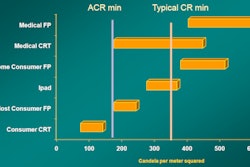AUSTIN, TX - There is very little difference between the performance of consumer-grade LCDs and medical-grade LCDs for the primary interpretation of radiography studies, according to research from Massachusetts General Hospital (MGH) in Boston.
As a result, there's "absolutely no reason" why consumer-grade LCDs can't be used for diagnostic reading, said Dr. David Hirschorn, of MGH and Staten Island University Hospital in New York. He presented the research during a scientific session Friday at the Society for Computer Applications in Radiology (SCAR) meeting.
Following up on similar research comparing consumer- and medical-grade LCDs in CT cases, the study team compared a Dell dual 2.3-megapixel (MP) color, 24-inch display with luminance of 400 cd/m2 with a medical-grade dual 3.0-MP gray, 21-inch display with luminance of 500 cd/m2 (Planar Systems, Beaverton, OR) for radiography applications.
Both displays had Impax software (Agfa HealthCare, Greenville, SC) installed on the system, and were calibrated to DICOM Part 14 grayscale standard display function (GSDF).
The study included 121 total radiographs, 91 of which were selected due to their subtle findings. Thirty were selected for controls. The displays were set in portrait mode.
Two attending radiologists each read all the cases on the consumer-grade display. After one month, they read the same cases, randomized in order, on the medical-grade LCD. All findings were recorded, and each finding was rated for conspicuity on a scale of 1 to 5.
The same findings were found in 117 of the 121 cases. Findings seen on the medical display by the same reader, but missed on the consumer display, included two rib fractures and one distal phalangeal erosion.
Findings seen on the consumer display, but missed on the medical display, included one medial malleolar fracture and one 1.0-cm pulmonary nodule, according to Hirschorn.
The researchers found no significant clinical difference between the two displays, he said.
"I believe at the very least, there's a strong argument to say that for clinical review, for nonprimary interpretation, that this is a no-brainer," Hirschorn said. For example, these displays could be placed in environments such as the ER and ICU, he said.
"I will tell you that at Staten Island University Hospital and MGH we take these monitors, calibrate them, and put them out there and read radiography off of them," Hirschorn said. "And so far we feel we're pretty comfortable with that."
MGH is currently piloting the consumer-grade LCDs in neurology studies, while Staten Island University Hospital is using them for radiography, he said.
"I have (the displays) side by side in the same room, and I'm always looking back and forth to see (if) I see any difference," he said. "So far I haven't."
Next the researchers will compare consumer- and medical-grade LCDs for mammography studies, Hirschorn said.
By Erik L. Ridley
AuntMinnie.com staff writer
April 29, 2006
Related Reading
Digital dashboard aids radiology workflow, April 28, 2006
Multivendor IT integration improves workflow, patient care, April 28, 2006
Higher monitor luminance may hinder performance, February 27, 2006
Radiologists can maintain visual acuity in filmless environments, December 29, 2005
Consumer flat-panel displays show promise for CT diagnosis, June 8, 2003
Copyright © 2006 AuntMinnie.com




















